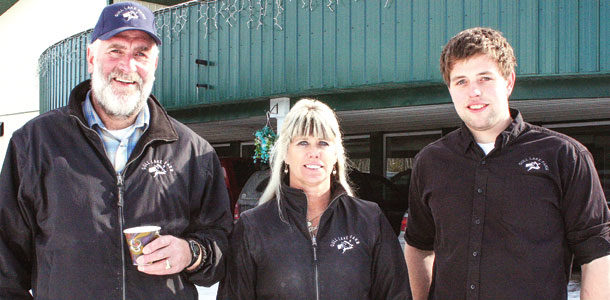Snow, ice and blustery temperatures make for a long winter in western Canada. Gull Lake Farm Ltd., located in Lacombe, Alberta, deals with average daily digits in the low teens (12ºF to 14ºF) throughout the winter months.
Dutch immigrants Wim and Nita Floryn and their son Marten (pictured above) milk just under 300 cows in a 32-stall internal rotary parlor.
Their facilities include freestall housing for the milking herd as well as room for 300 heifers. In addition to the dairy, the family also breeds Friesian and Dutch Warmblood horses. PD

Peggy Coffeen
Editor
Progressive Dairyman
Employee management
Are you ready for winter? Here’s a quick checklist to help prepare the people on your dairy for the cold:
- Show everyone where to dump out pails of water … not right outside the door.
- Make sure all the door knobs latch securely when doors are pulled closed.
- Give each shift their own set of overhead door openers … hold everyone accountable for taking care of theirs.
- Set and secure all thermostats in heated areas (break room, office, parlor, etc.).
- On the first payday of each month, have employees throw out the winter clothes that no one is using.
Provided by Tom Wall, dairy coach, Dairy Interactive LLC and Language Links LLC

Facilities maintenance
Snow and ice can make for a dangerous combination on, in and around buildings on the dairy. Follow these tips to minimize hazards:
- Remove snow regularly from all walks and overhead doors to prevent snow and ice build-up.
- Remove snow from roofs to prevent collapse.
- Have your generator serviced and test it weekly; stock up on winter diesel.
- Cover all unnecessary fans and air inlets.
- Insulate above-ground water lines and lower water levels in drinkers.
- Drain soaker and mister lines.
- Use salt or sand on alleys that have potential for freezing.
- Check water heater and air compressor vents regularly for ice or snow build-up.
Provided by Willem Vendrig, project manager, United Development, LLC

Key considerations for vaccine handling in extremely cold weather
- Follow the manufacturers’ recommendations regarding storage temperatures and cautions against freezing.
- Freezing can separate critical vaccine components.
- Protect vaccine in syringes and needles from freezing between uses.
- Traditional coolers for storage can serve as the heat source. (Holes can be drilled in the lid for syringe placement between vaccinations.)
- Warm water bottles or even pre-heated gel packs can be used as a heat source.
- When reconstituting vaccine ahead of use, physically separate (bubble wrap, etc.) the vaccine from the heat source to avoid overheating.
Provided by Tom Shelton, DVM, M.S., senior technical services veterinarian, Merck Animal Health










